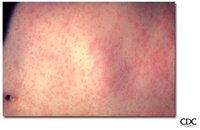Rubeola
Measles, also known as rubeola, is a disease caused by a virus of the genus Morbillivirus. more...
Reports of measles go back to at least 700, however, the first scientific description of the disease and its distinction from smallpox is attributed to the Muslim physician Ibn Razi (Rhazes) 860-932 who published a book entitled "Smallpox and Measles" (in Arabic: Kitab fi al-jadari wa-al-hasbah). In 1954, the virus causing the disease was isolated, and licensed vaccines to prevent the disease became available in 1963.
Measles is spread through respiration (contact with fluids from an infected person's nose and mouth, either directly or through aerosol transmission), and is highly contagious - 90% of people without immunity sharing a house with an infected person will catch it. Airborne precautions should be taken for all suspected cases of measles.
The incubation period usually lasts for 10-12 days (during which there are no symptoms).
Infected people remain contagious from the appearance of the first symptoms until 3-5 days after the rash appears.
Symptoms
The classical symptoms of measles include a fever for at least three days duration, and the three C's - cough, coryza (runny nose) and conjunctivitis (red eyes). The fever may reach up to 40 degrees Celsius (105 Fahrenheit). Koplik's spots seen inside the mouth are pathognomic (diagnostic) for measles but are not often seen, even in real cases of measles, because they are transient and may disappear within a day of arising.
The rash in measles is classically described as a generalised, maculopapular, erythematous rash that begins several days after the fever starts. It starts on the head before spreading to cover most of the body. The measles rash also classically "stains" by changing colour to dark brown from red before disappearing later. The rash can be itchy.
Diagnosis
A detailed history should be taken including course of the disease so far, vaccination history, contact history, and travel history.
Clinical diagnosis of measles requires a history of fever of at least three days together with at least one of the three Cs above. Observation of Koplik's spots is also diagnostic of measles.
Alternatively, laboratory diagnosis of measles can be done with confirmation of positive measles IgM antibodies or isolation of measles virus RNA from respiratory specimens.
Positive contact with other patients known to have measles adds strong epidemiological evidence to the diagnosis.
Treatment
There is no specific treatment for uncomplicated measles. Patients with uncomplicated measles will recover with rest and supportive treatment.
Complications
Complications with measles are relatively common, ranging from relatively common and less serious diarrhea, to pneumonia and encephalitis (subacute sclerosing panencephalitis). Complications are usually more severe amongst adults who catch the virus.
Read more at Wikipedia.org



